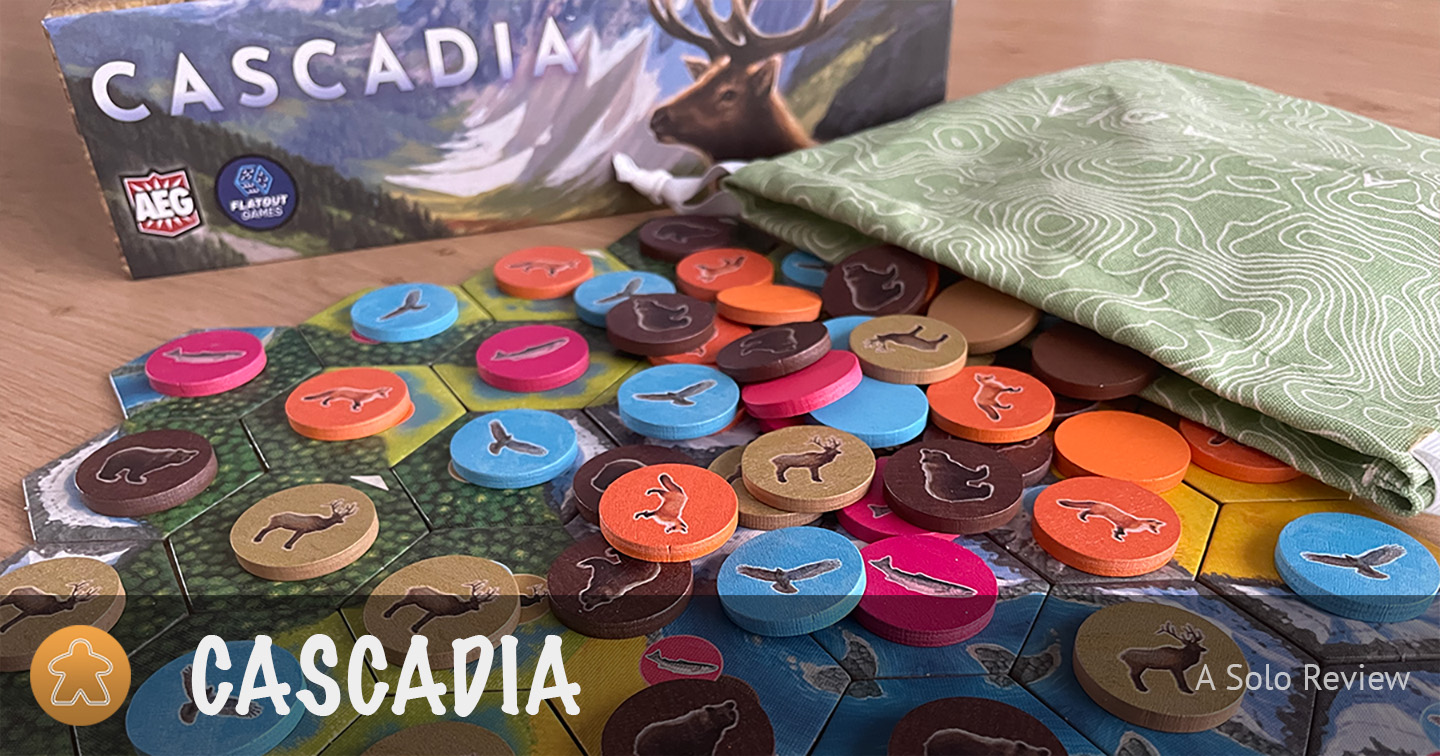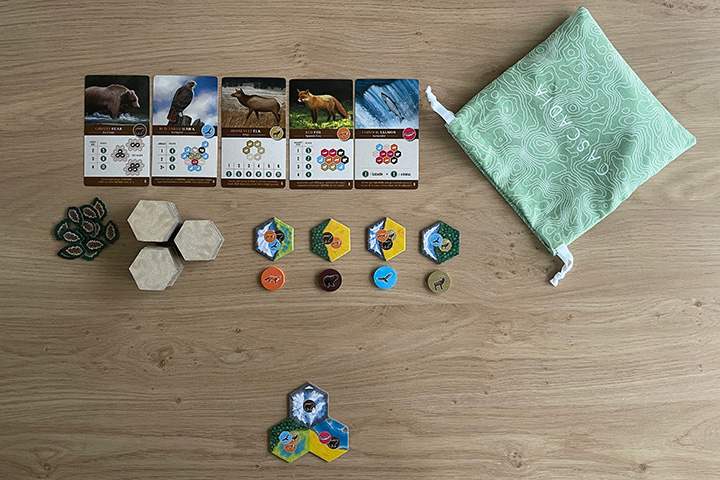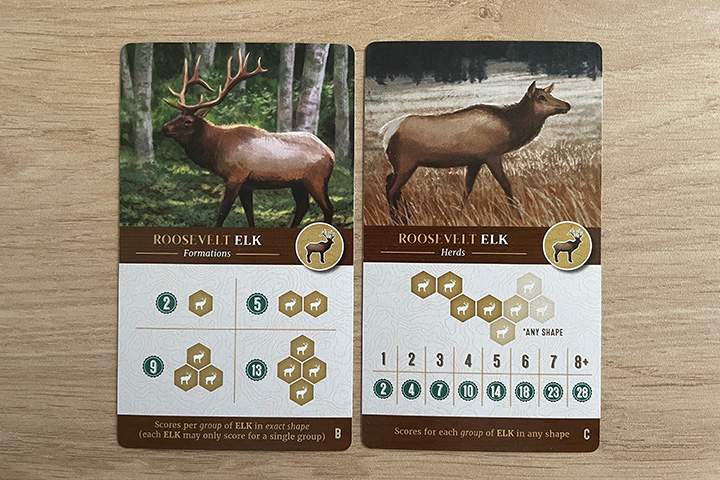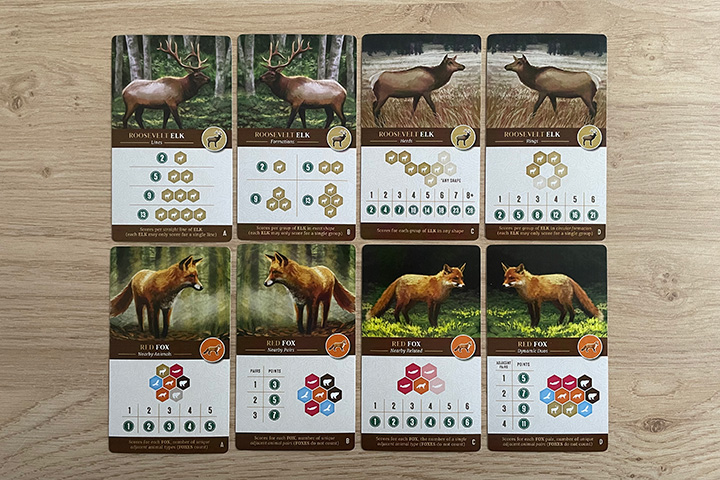Cascadia - A Solo Review
26 Nov 2021
Cascadia is another name for the Pacific Northwest, a diverse geographic region in western North America. It is known for its vast mountain ranges, its dry plateaus, its lush forests and its fjords, bays and islands. These ecoregions form the habitats of a wide range of beautiful animals. Are you able to recreate an accurate representation of the region and populate it with wildlife?
Name: Cascadia
Designer: Randy Flynn (solo mode by
Shawn Stankewich)
Publisher: Flatout Games / Alderac Entertainment Group
Game type: drafting, tile placement, pattern building
What is Cascadia?
Cascadia consists of 85 hexagonal habitat tiles and 100 round wooden animal tokens (bears, elks, foxes, hawks and salmons). Every habitat tile is made up out of either one or two of the five different terrain types (mountains, prairies, forests, wetlands and rivers) and can hold one animal token of the one to three animal types specified on the tile itself.
By placing the habitat tiles in your player area you create your own terrain area which you can then populate with animals. After 20 turns you score points based on the size of contiguous terrain types and the patterns in which you placed the different animal types. These patterns are determined by a random scoring rule per animal type, drawn at the start of the game.
How does it play?
At the start of the game you take a fixed number of random habitat tiles —43 for the solo game— and place them in a few face down stacks. You turn over four tiles and place them next to each other. Then you pair each of the four tiles with a random animal token which you draw from the included cloth bag. Next you select a scoring card for each of the five animal types (more on these later). Finally, you randomly pick a big starting tile. These starting tiles are the size of three hexagonal habitat tiles forming one big tile.

On your turn you pick one of the four available pairs of habitat tiles and animal tokens. You have to add the habitat tile to your area. There are no limitations when placing a habitat tile; as long as it is joined to your area by at least one side, it’s OK. The terrain types on neighboring tiles don’t have to match, but remember that you score points for contiguous terrain types. Next you may place the animal token on an unoccupied tile in your area. The only rule here is that the habitat tile has to display a picture of the animal token.
There are a few special habitat tiles that make things a bit more interesting though. Among the 85 habitat tiles, you will find 25 so called keystone tiles. These tiles contain only one terrain type and can hold only one specific animal type. What’s special about these tiles is that you gain a nature token when you place an animal token on them. Every nature token you have left at the end of the game is worth one point, but you can also use them during the game to get some more flexibility when drafting a tile and a token. When it’s your turn to pick a paired tile and token, you can spend a nature token to do one of two things: you can replace any number of the four available tokens with random tokens from the bag, or, instead of picking a fixed pair, you can select any one tile and any one token.
After you have selected and placed a tile and a token, your turn is over.
There’s no real AI in the solo mode. Instead, they added a mechanisms to simulate another player taking habitat tiles and animal tokens. After your turn, you simply remove the rightmost habitat tile and animal token, you slide the remaining two tiles and tokens to the right and you refill from the left until there are four pairs again, and that’s basically it when it comes to the turn structure.
When there are only three instead of four tiles left to choose from, the game ends. You start the game with 43 tiles, so when there are only three left, you and the “AI” will each have taken 20 turns.

When calculating your score, you look at the largest contiguous area per terrain type and you score one point per tile in that area. (You get an extra two points for every terrain type where the largest area was 7 tiles or more.) Scoring the animals is a bit trickier. I’ve already mentioned that you pick a scoring card per animal type at the start of the game. These cards determine how you score points for their respective animal type. Bears typically want to be placed in groups, salmons like to be placed in a line, foxes like to be surrounded by different types of animals, … There are four scoring cards per animal type and every card specifies the exact rules. So while bears want to be placed in groups, one card might say you get 10 points for each group of exactly three bears and another card might say you get 5, 8 or 13 points for groups of two, three or four bears respectively.

After adding up your score for every terrain type and animal type (and adding any nature tokens you may have left), you can compare your score to a table with scoring ranks in the rule book.
The rule book also contains a list of 15 scenarios and 35 achievements. A scenario tells you which scoring card for each animal type you need to use and gives you certain goals you need to meet. Some even add extra rules or limitations (e.g. “score 90 points, have at least 5 nature tokens, bears and foxes cannot be adjacent”). Achievements are more generic like “have no foxes” or “use two instead of one nature token when spending them”.
Additionally, if you want to play with kids or people who are not a fan of the more complex scoring rules, you can use the family or intermediate scoring card instead of using one card per animal type.
What does it look and feel like?
The cardboard used for the habitat tiles and nature tokens is sturdy and thick and has a nice linen finish. The terrain types are not too busy or detailed and not too simplistic either.
The wooded animal tokens have the animal type printed on them, no stickers here. I really like that these tokens are wood instead of cardboard. The cloth bag is very nice. Instead of a boring fabric in one color, this one has a nice thematic pattern that totally fits the game.
The cards are nice and big (tarot sized I think) and have a linen finish just like the cardboard tiles and tokens.


How much time does it take?
Depending on how much time you take to think about your drafting and placement options, I would say this game can be played in about 30 to 45 minutes, including setup and teardown.
The wooden animal tokens are stored in the cloth bag and the tiles are placed in a designated area in the insert. This helps in keeping setup and teardown to a minimum.

What is my verdict?
My initial idea was that this was going to be an easy game. I mean, you’re placing tiles and adding animals to them, how hard can it be? What I had totally underestimated were the subtle tensions introduced by the drafting of a paired tile and token, the two ways of scoring (terrain vs animals) and the scoring rules for the different animal types. You could pick this pair so you can place the tile there to make your mountain range bigger, but if you do that, your plan of surrounding the nearby fox is ruined because the new tile can only hold a salmon or an elk and you need a bear. Or maybe you can place it over there? That will allow you to extend your group of elks, but it cuts off your swamp area. But then again, if you take that tile, you’ll need to take the hawk token as well and you don’t really have use for it at the moment. What to do, what to do?
Regardless of all the interesting choices, I find Cascadia very relaxing to play. It’s probably because of that, that I don’t have an issue with the beat your own score solo mode. This is an ideal game to play in the evening on a week night, when you’re tired from work and need to unwind for a bit. At those moments, I don’t really mind not having an AI opponent to compete against.
Overall I am very happy with Cascadia. It’s not a game I want to play every day and even though it’s relatively quick to play, I don’t really play it more than twice in a row. However, if I want to play a game but I’m a bit too tired to play something like Viscounts of the West Kingdom or Teotihuacan, Cascadia is always a good option.
Score
To make things easier for myself, I use the same scoring categories Board Game Geek uses.
Comments
I'm sorry, I don't support comments on my website. If you want to discuss the game or my review, feel free comment on this dedicated Instagram post or my review on BGG.